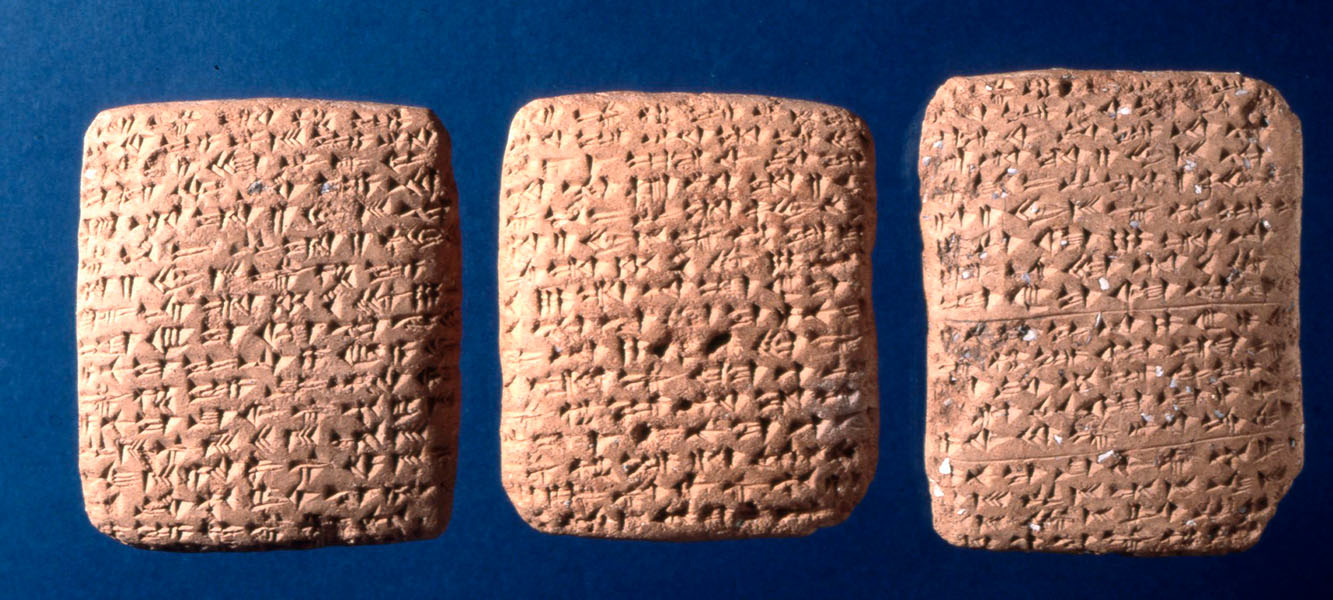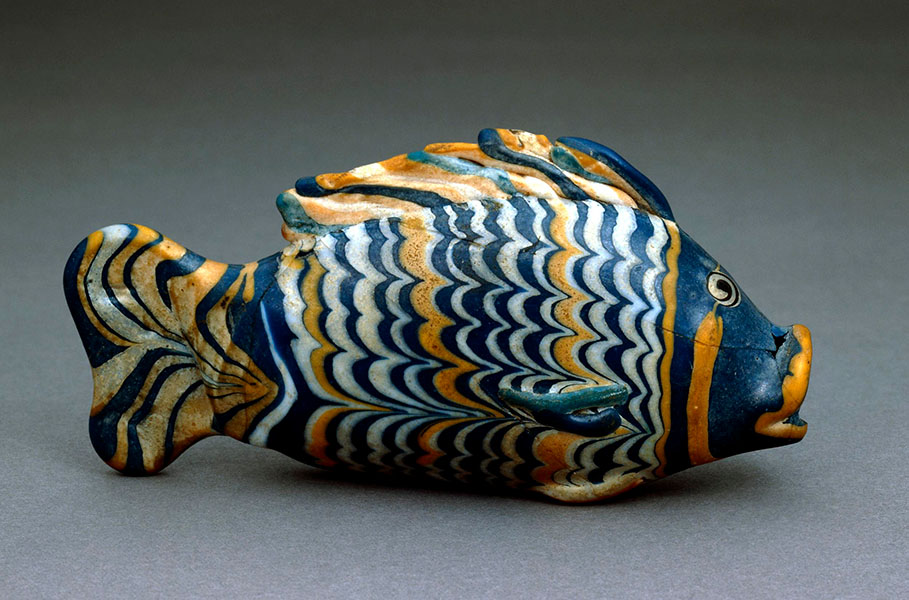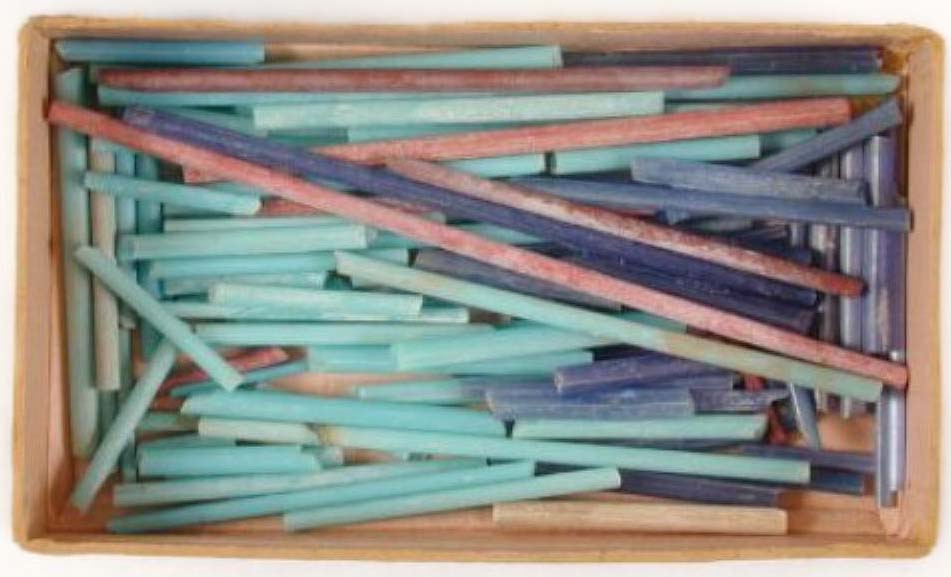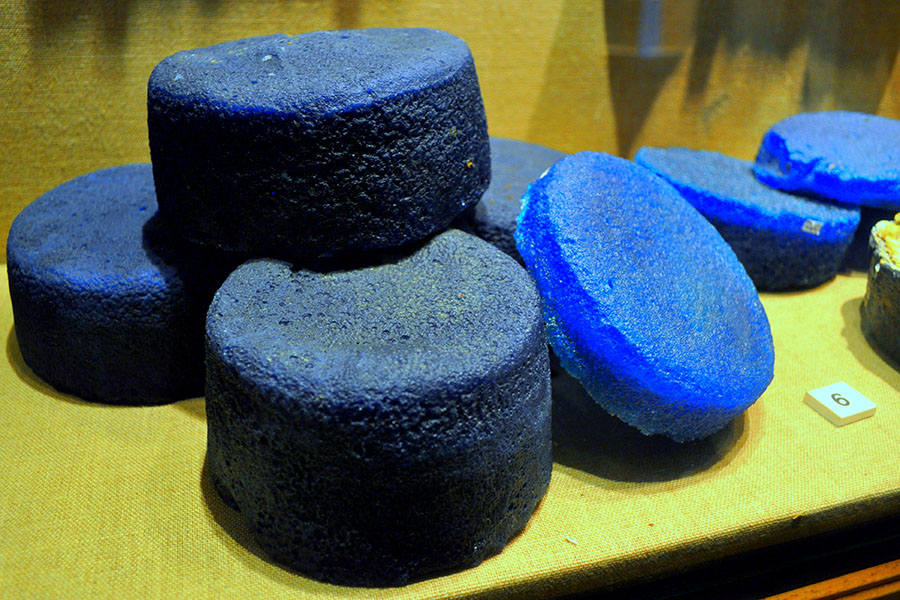The ancient origins of glass
Featuring ingots, shipwrecks, pharaohs and an international trade in colors, the material's rich history is being traced using modern archaeology and materials science
Today, glass is ordinary, on-the-kitchen-shelf stuff. But early in its history, glass was bling for kings.Thousands of years ago, the pharaohs of ancient Egypt surrounded themselves with the stuff, even in death, leaving stunning specimens for archaeologists to uncover. King Tutankhamen's tomb housed a decorative writing palette and two blue-hued headrests made of solid glass that may once have supported the head of sleeping royals. His funerary mask sports blue glass inlays that alternate with gold to frame the king's face.
In a world filled with the buff, brown and sand hues of more utilitarian Late Bronze Age materials, glass — saturated with blue, purple, turquoise, yellow, red and white — would have afforded the most striking colors other than gemstones, says Andrew Shortland, an archaeological scientist at Cranfield University in Shrivenham, England. In a hierarchy of materials, glass would have sat slightly beneath silver and gold and would have been valued as much as precious stones were.
But many questions remain about the prized material. Where was glass first fashioned? How was it worked and colored, and passed around the ancient world? Though much is still mysterious, in the last few decades materials science techniques and a reanalysis of artifacts excavated in the past have begun to fill in details.
This analysis, in turn, opens a window onto the lives of Bronze Age artisans, traders and kings, and the international connections between them.

The Amarna Letters, clay tablets carrying the cuneiform correspondence of ancient kings and excavated at Tell el-Amarna in modern-day Egypt, include references to glass. A number from the Canaanite ruler Yidya of Ashkelon (like these shown) include one that comments on an order of glass for Pharaoh: "As to the king, my lord's, having ordered some glass, I herewith send to the king, my lord, 30 ("pieces") of glass. Moreover, who is the dog that would not obey the orders of the king, my lord, the Sun from the sky, the son of the Sun, whom the Sun loves?"
CREDIT: © THE TRUSTEES OF THE BRITISH MUSEUM
Glass from the past
Glass, both ancient and modern, is a material usually made of silicon dioxide, or silica, that is characterized by its disorderly atoms. In crystalline quartz, atoms are pinned to regularly spaced positions in a repeating pattern. But in glass, the same building blocks — a silicon atom buddied up with oxygens — are arranged topsy-turvy.
Archaeologists have found glass beads dating to as early as the third millenium BCE. Glazes based on the same materials and technology date earlier still. But it was in the Late Bronze Age — 1600 to 1200 BCE — that the use of glass seems to have really taken off, in Egypt, Mycenaean Greece and Mesopotamia, also called the Near East (located in what's now Syria and Iraq).
Unlike today, glass of those times was often opaque and saturated with color, and the source of the silica was crushed quartz pebbles, not sand. Clever ancients figured out how to lower the melting temperature of the crushed quartz to what could be reached in Bronze Age furnaces: They used the ash of desert plants, which contain high levels of salts such as sodium carbonate or bicarbonates. The plants also contain lime — calcium oxide — that made the glass more stable. Ancient glassmakers also added materials that impart color to glass, such as cobalt for dark blue, or lead antimonate for yellow. The ingredients melded in the melt, contributing chemical clues that researchers look for today.
"We can start to parse the raw materials that went into the production of the glass and then suggest where in the world it came from," says materials scientist Marc Walton of Northwestern University in Evanston, Illinois, coauthor of an article about materials science and archaeological artifacts and artwork in the 2021 Annual Review of Materials Research.
But those clues have taken researchers only so far. When Shortland and colleagues were investigating glass's origins around 20 years ago, glass from Egypt, the Near East and Greece appeared to be chemical lookalikes, difficult to distinguish based on the techniques available at the time.
The exception was blue glass, thanks to work by Polish-born chemist Alexander Kaczmarczyk who in the 1980s discovered that elements such as aluminum, manganese, nickel and zinc tag along with the cobalt that gives glass an abyssal blue hue. By examining the relative amounts of these, Kaczmarczyk's team even tracked the cobalt ore used for blue coloring to its mineral source in specific Egyptian oases.
Picking up where Kaczmarczyk left off, Shortland set out to understand how ancient Egyptians worked with that cobalt ore. The material, a sulfate-containing compound called alum, won't incorporate into the glass. But in the lab, Shortland and colleagues reproduced a chemical reaction that Late Bronze Age craftspeople may have used to create a compatible pigment. And they created a deep blue glass that did, in fact, resemble Egyptian blue glass.

This glass fish was found in a fairly modest private house in Amarna, buried under a plaster floor along with a few other objects. It may once have contained ointment.
CREDIT: © THE TRUSTEES OF THE BRITISH MUSEUM
In the first years of this century, a relatively new method offered more insights. Called laser ablation inductively coupled mass spectrometry, or LA-ICP-MS, the technique uses a laser to remove a tiny speck of material, invisible to the naked eye. ("That's very much more acceptable to a museum than getting the big hammer out and taking a piece off," Shortland says.) It then uses mass spectrometry to measure a suite of elements, creating a chemical fingerprint of the sample.
Based on this method, in 2009 Shortland, Walton and others analyzed Late Bronze Age glass beads unearthed in Greece, which some researchers proposed had its own glass production workshops. The analysis revealed that the Grecian glass had either Near Eastern or Egyptian signatures, supporting the idea that Greece imported glass from both places and, though it may have worked the glass, did not make it locally. Egyptian glasses tended to have higher levels of lanthanum, zirconium and titanium, while Near Eastern glasses tended to have more chromium.
Obscure origins
But where was glass first birthed? For at least 100 years, researchers have debated over two main contenders: the Near East and Egypt. Based on some beautiful, well-preserved glass artifacts dating from around 1500 BCE, Egypt was favored at first. But by the 1980s, researchers were placing their bets on the Near East after excavators found loads of glass at Nuzi, a Late Bronze Age provincial town in modern-day Iraq, thought to date from the 1500s BCE.
Around that same time, though, a reanalysis of archaeological texts revealed that Nuzi was 100 to 150 years younger than estimated, and the Egyptian glass industry from that time period seems to have been more advanced — favoring Egypt once again.

Glass pieces collected at Amarna.
CREDIT: © UNIVERSITY COLLEGE LONDON 2015
But that isn't the end of the story. Glass can degrade, especially in wet conditions. Objects from Egypt's ancient tombs and towns have lasted millennia, aided by the desert's nearly ideal preservation environment. Near Eastern glass, on the other hand, from tombs on Mesopotamian floodplains, more frequently faced attacks by water, which can leach out stabilizing compounds and turn glass to flaky powder.
This deteriorated glass is difficult to identify and impossible to display, meaning lots of Near East glass may be missed. "I think a lot of the glass has effectively disappeared," Shortland says. "Early excavations were less bothered about this flaky ex-glass than they might have been about other things."
The bottom line: "You can't really decide which is the earliest at the moment," Shortland says.
Finding glassmaking
It's even tricky to parse where glass was made at all. That's partly because the material was frequently exchanged, both as finished objects and as raw glass to be worked into beads or vessels.
Glass helped to tie ancient empires together, says Thilo Rehren, an archaeological materials scientist at the Cyprus Institute in Nicosia who has examined the craftsmanship behind objects from Tut's tomb, among others. Kings shipped materials to other rulers, expecting goods or loyalty in return, he says. Ancient inventories from the Late Bronze Age reveal an exchange of ivory, gems, wood, animals, people and more, and while the role of glass in this convention of gifting and tribute isn't fully understood, the composition of artifacts supports glass swaps too.
In a glass bead necklace excavated in Gurob, Egypt, in an area thought to once have been a harem palace, Shortland and colleagues found the chemical signature associated with Mesopotamia: relatively high levels of chromium. The beads' location implied that the bling was probably gifted to Pharaoh Thutmose III along with Near Eastern women who became the king's wives. With chemistry on the case, "we're now just beginning to see some of this exchange going on between Egypt and other areas," Shortland says.

Archaeology and materials science has turned up clues to where glass was made in the ancient world and how it was passed around among empires during the Late Bronze Age.
In the early 1980s, divers found the mother lode of such exchanges off the coast of Turkey in a sunken vessel from the 1300s BCE called the Uluburun shipwreck. Analysis of its contents reveals a global economy, says Caroline Jackson, an archaeologist at the University of Sheffield in England. Possibly a Phoenician ship on a gift-giving expedition, the vessel was hauling items from all over: ivory, copper, tin, even amber from the Baltic. From the wreck, excavators retrieved a load of colored glass — 175 unfinished blocks, called ingots, for glassworking.
Most of the ingots were cobalt-colored deep blue, but the ship was also ferrying purple and turquoise ingots. Jackson and her colleagues chipped a few small fragments off of three ingots and reported in 2010 that the raw glass blocks were Egyptian in origin, based on the concentration of trace metals.
Tracing glassmaking
Another reason why it's tricky to identify sites for glassmaking is that the process makes little waste. "You get a finished object, and that, of course, goes into the museum," Rehren says. That led him and archaeologist Edgar Pusch, working in in a flea-ridden dig house on the Nile Delta about 20 years ago, to ponder pottery pieces for signs of an ancient glassmaking studio. The site, near present day Qantir, Egypt, was the capital of Pharaoh Ramses II in the 1200s BCE.
Rehren and Pusch saw that many of the vessels had a lime-rich layer, which would have acted as a nonstick barrier between glass and the ceramic, allowing glass to be lifted out easily. Some of these suspected glassmaking vessels — including a reused beer jar — contained white, foamy-looking semi-finished glass. Rehren and Pusch also linked the color of the pottery vessels to the temperature they'd withstood in the furnace. At around 900 degrees Celsius, the raw materials could have been melted, to make that semi-finished glass. But some crucibles were dark red or black, suggesting they'd been heated to at least 1,000 degrees Celsius, a high enough temperature to finish melting the glass and color it evenly to produce a glass ingot.
Some crucibles even contained lingering bits of red glass, colored with copper. "We were able to identify the evidence for glassmaking," Rehren says. "Nobody knew what it should have looked like."

Blue glass ingots from the Uluburun shipwreck.
CREDIT: PANEGYRICS OF GRANOVETTER / FLICKR
Since then, Rehren and colleagues have found similar evidence of glassmaking and ingot production at other sites, including the ancient desert city of Tell el-Amarna, known as Amarna for short, briefly the capital of Akhenaton during the 1300s BCE. And they noticed an interesting pattern. In Amarna's crucibles, only cobalt blue glass fragments showed up. But at Qantir, where red-imparting copper was also worked to make bronze, excavated crucibles contain predominantly red glass fragments. ("Those people knew exactly how to deal with copper — that was their special skill," Rehren says.) At Qantir, Egyptian Egyptologist Mahmoud Hamza even unearthed a large corroded red glass ingot in the 1920s. And at a site called Lisht, crucibles with glass remains contain primarily turquoise-colored fragments.
The monochrome finds at each site suggest that workshops specialized in one color, Rehren says. But artisans apparently had access to a rainbow. At Amarna, glass rods excavated from the site — probably made from re-melted ingots — come in a variety of colors, supporting the idea that colored ingots were shipped and traded for glassworking at many locations.
Glass on the groundArchaeologists continue to pursue the story of glass at Amarna — and, in some cases, to more carefully repeat the explorations of earlier archaeologists.
In 1921-22, a British team led by archaeologist Leonard Woolley (most famous for his excavations at Ur) excavated Amarna. "Let's put it bluntly — he made a total mess," says Anna Hodgkinson, an Egyptologist and archaeologist at the Free University of Berlin. In a hurry and focused on more showy finds, Woolley didn't do due diligence in documenting the glass. Excavating in 2014 and 2017, Hodgkinson and colleagues worked to pick up the missed pieces.
Hodgkinson's team found glass rods and chips all over the area of Amarna they excavated. Some were unearthed near relatively low-status households without kilns, a headscratcher because of the assumed role of glass in signifying status. Inspired by even older Egyptian art that depicted two metalworkers blowing into a fire with pipes, the archaeologists wondered whether small fires could be used to work glass. Sweating and getting stinky around the flames, they discovered they could reach high enough temperatures to form beads in smaller fires than those typically associated with glasswork. Such tiny fireplaces may have been missed by earlier excavators, Hodgkinson says, so perhaps glassworking was less exclusive than researchers have always thought. Maybe women and children were also involved, Hodgkinson speculates, reflecting on the many hands required to maintain the fire.

Top: Art from a tomb showing metal workers using blowpipes to ventilate a small fire during an era that pre-dates Amarna. Bottom: In an archaeological experiment, researchers tested whether it was possible to make glass beads like those found at Amarna in a similar manner, blowing into the fire using pipes.
CREDIT: ANNA K. HODGKINSON (TOP), ANDREAS MESLI (BOTTOM)
Rehren, too, has been rethinking whom glass was for, since Near Eastern merchant towns had so much of it and large amounts were shipped to Greece. "It doesn't smell to me like a closely controlled royal commodity," he says. "I'm convinced that we will, in 5, 10 years, be able to argue that glass was an expensive and specialist commodity, but not a tightly controlled one." Elite, but

not just for royalty.
Researchers are also starting to use materials science to track down a potential trade in colors. In 2020, Shortland and colleagues reported using isotopes — versions of elements that differ in their atomic weights — to trace the source of antimony, an element that can be used to create a yellow color or that can make glass opaque. "The vast majority of the very early glass — that's the beginning of glassmaking — has antimony in it," Shortland says. But antimony is quite rare, leading Shortland's team to wonder where ancient glassmakers got it from.
The antimony isotopes in the glass, they found, matched ores containing antimony sulfide, or stibnite, from present-day Georgia in the Caucasus — one of the best pieces of evidence for an international trade in colors.
Researchers are continuing to examine the era of first glass. While Egypt has gotten a large share of the attention, there are many sites in the Near East that archaeologists could still excavate in search of new leads. And with modern-day restrictions on moving objects to other countries or even off-site for analysis, Hodgkinson and other archaeologists are working to apply portable methods in the field and develop collaborations with local researchers. Meanwhile, many old objects may yield new clues as they are analyzed again with more powerful techniques.
As our historical knowledge about glass continues to be shaped, Rehren cautions against certainty in the conclusions. Though archaeologists, aided by records and what's known of cultural contexts, carefully infer the significance and saga of artifacts, only a fraction of a percent of the materials that once littered any given site even survives today. "You get conflicting information, conflicting ideas," he says. All these fragments of information, of glass, "you can assemble in different ways to make different pictures."
10.1146/knowable-111721-1
-- Sent from my Linux system.
No comments:
Post a Comment